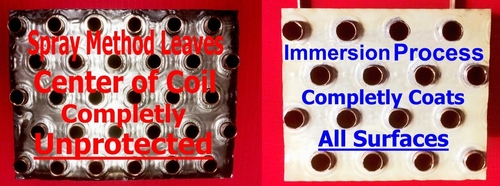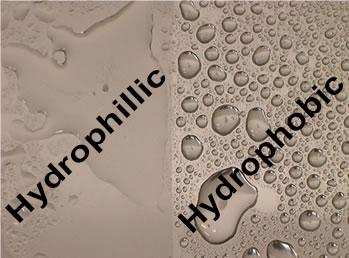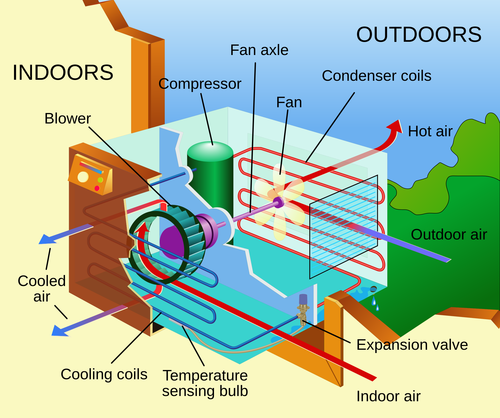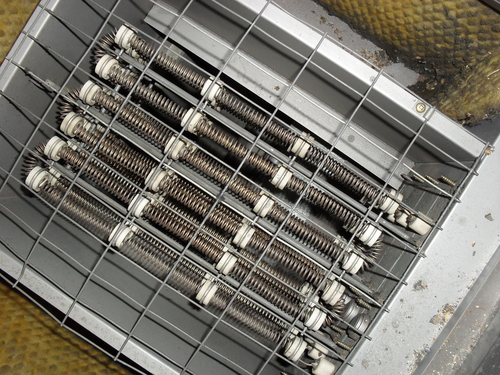If your business works with heating or cooling coils or your product contains a coil (or two), you are likely aware that the coil can be one of the most functionally important, and one of the most delicate, parts of a machine. You are also undoubtedly aware that when the coil portion of a device isn’t working, the device as a whole isn’t working, and that means down-time for your customer... not good.
There are two main causes of failure for heat transfer coils in appliances and HVAC equipment: mechanical damage and corrosion. Aside from incorporating physical protection for the coil, there is not much that can be done to prevent coil failures due to mechanical damage. Corrosion, on the other hand, is much more preventable.
Through the use of specially formulated coatings, corrosion can be drastically reduced or even eliminated. When it comes to coatings, the choices can seem endless, and it’s often very hard to differentiate one HVAC or AC coil coating product from another. When choosing a coil coating, there are many considerations and some very specific questions you will need answered. The information you need is often not contained in those glossy brochures being handed out at the trade shows. Although there are some great coating products (and processes) out there, there are also many that may not be up to the job. Don’t lead your company down the wrong path with an inferior coating choice for your application; ask the right questions, get the facts, and make a fully informed decision based on hard information, not just marketing claims.
Here are some basic questions you need answered about any coating before you commit:
• How is the coil coating applied?
Application method is key in how well the coil will be protected. The application of coatings generally fall within one of three distinct categories: Spray (Heresite ™, BlyGold ™ ect..), Immersion (AmeriCoat ™ Ozkem ™ ect...), and Electrically Applied (Electro-Fin ® & E-Coat).
Spray HVAC and AC coil coating is applied just as the name implies—sprayed onto external surfaces of the coil.
Spray Applied Pros:
• Ease of application
• Economically priced
Spray Applied Cons:
• Does not protect all surfaces of coil. Center of coil is left unprotected. Spray applied methods can’t penetrate into the center/core of the coil.
• Spray coating formulations are generally more brittle and prone to flaking off over time and/or when bumped during installation or servicing.
Immersion Applied Pros:
• Uniform coverage and protection of all coil surfaces, seen & unseen
• Innovative new formulations rival and can surpass even the electrically applied HVAC and AC coil coating durability.
• Certain formulations of immersion applied coatings have outperformed the more expensive electrically applied coatings in independent testing.
• Some formulations are FDA approved and safe for indirect contact with food.
• Accepted by several HVAC and foodservice OEM’s.
Immersion Applied Cons:
• Costs are generally a little more expensive than spray-applied coil coatings, but somewhat less than electrically applied.
• The process for coil preparation, application and process must be much more controlled than spray applied techniques, taking a bit more time and expertise to complete.
Electrically Applied Pros:
• The most uniform coverage, on both seen & unseen surfaces.
• Highly controlled environment for application, yielding predictable results.
• Better protection than spray-applied coatings and comparable with some of the best immersion applied HVAC and AC coil coatings.
• Widely accepted by OEMs.
Electrically Applied Cons:
• Only applied by one company, and is generally more expensive than spray or immersion applied HVAC or AC coil coatings.
• All coils must be shipped to the vendor’s location for coating application.
• Often takes 1-2 weeks for completion.
• Not FDA approved for contact with food.
• Some immersion applied coatings have greater long-term durability (as independently tested) than electrically applied.
• How is the Coating Cured? Proper curing is critical for the protection longevity of any coating.

• Spray Applied: Some HVAC and AC coil coatings air-dry and some are heat cured. Heat curing is preferred.
• Immersion Applied: The best Immersion coatings are heat cured, some are air-dried. Heat curing is preferred.
• Electrically Applied: Heat Cured.
• How Long Will the Coating Protect the Coil? Review independent testing results.
• Each applier should have a technical data sheet for their coating offering, request it.
• The best coatings have undergone extensive independent testing for the following: Salt Spray, Acidified Salt Spray, Anti Bacteria & Mold, Moisture S02 Testing, Food Contact.
• The Salt Spray test is key; the best coatings can withstand 10,000 hours or more.
• How Does the Coating React to UV Light? Most HVAC and AC coil coatings don’t tolerate full UV exposure very well, some better than others.
• Some coatings can accept a top-coat of another product to help with UV, and some use a titanium binder formula (rather than the less UV tolerant copper). Some cannot be made to tolerate high doses of UV at all; ask your potential vendor about how their product deals with UV light exposure.
• How Does the HVAC and AC Coil Coating Effect Heat Transfer?
• The coating formula and application method will dictate heat transfer loss.
• The best coatings are specifically formulated for coil protection while also facilitating heat transfer, and can offer less than a 1% degradation. The ideal 1% or less degradation is available with select vendors in each of the three application method types. Check with your potential vendor. This information should be on their coating technical data sheet.
• Is the Coating Hydrophobic, Hydrophilic, or Neither? This refers to how moisture reacts with the coating surfaces.
• Hydrophobic: Repels moisture, beading up, and running off vigorously. Best choice for most applications. Hydrophobic coils “sweat” carrying debris from surfaces, becomes almost self-cleaning. Also helps keep low airflow refrigeration coils from “ice-bridging” between the fin surfaces.
• Hydrophilic: Spreads moisture out evenly across coating surfaces (a sheeting effect). Useful in situations where coil is intended to stay wet or purposely sprayed with water to enhance heat transfer.
• Non-Engineered for Water Interaction: Does not address moisture/water interaction, not recommended.

• What is the finished color of the coil coating?
• Most coils are visible in some way, and some colors can be more noticeable than others. Nobody wants attention drawn to the coils on their HVAC units or appliances. For aesthetic purposes, choose HVAC coil coating colors that blend the best with a coil’s surroundings. Color can also impact the latent heat absorption rate from sunlight; darker colors can attract heat, while lighter colors can help reflect it.
• Request a sample : Most reputable coating appliers will readily offer samples, but sometimes you need to ask. Many times, the sample offered is simply a piece of fin material treated with their coating process. Those samples should only be regarded as a demonstrator of color. If you really want to judge the supplier’s finish product, you will want an actual coated coil sample (some coating appliers will even demonstrate their coating on one of your coils free of charge). A full coil sample will exhibit the coating facility’s ability (or inability) to apply their product evenly and with the desired finish, texture and hardness. There are many different surfaces and textures on a real coil, and the fin material is just one of them. You want a coating product and application process that looks good on all the coil’s surfaces and creates a look and function you can be proud to show to your customers. Many first time coating shoppers are surprised at what some coating appliers consider “functionally acceptable” as opposed to your higher expectations. Don’t settle… coated coils can work great and look great too, if you do your homework and choose wisely.
• You’ve decided on the best HVAC or AC coil coating for your application... now what?
When selecting a coating type and vendor, ask the important questions and get the answers you need to make an informed decision. Your potential vendor will know you are well versed and you’ll better position your company to favorably negotiate the details of the coating work contract. Once you decide on a coating product and process, you will surely want to know how to get the best price. The key to getting great pricing is knowing how your coating applier can save time and money on your job. Help facilitate those cost-saving situations for them and then ask that those savings be passed on to you… their new customer. This approach works best with small and medium sized appliers, as large scale coating firms may not have the flexibility or potential efficiencies that can be created for you to take advantage of. So how can you help a coating company help you? Here are the ways you and coating appliers can save:
• Issue PO’s in batch quantities that most closely match the capacity of their oven. If your selected coating is heat cured, the oven is where your coating vendor will expend the greatest deal of energy (quite literally) to deliver your final product. Energy is expensive, and if you can help them get as many pieces as possible into each firing of their oven, then their cost per piece will go down, and so should yours.
• Offer a blanket PO for your coating work, up to 1 year out. Why? Because it can allow your vendor to plan their time and materials in the most efficient manner. Liquid coating raw material can be very expensive and some can take months to formulate and receive. How does a vendor know how much to keep in stock or have waiting for jobs? Blanket PO’s can help them forecast their demand and facilitate production planning. That means on-time deliveries and more controlled costs for everyone.
• Let your vendor keep some stock to coat during their slower times. Just like every business, coating facilities have busy weeks and slower weeks. A steadily full shop is the most efficient and profitable shop for any manufacturer, so help your vendor smooth out the peaks and valleys by leaving some stock at their facility to coat (at their discretion) in between their busy times. Set a completion date on your PO and allow them a few weeks or months to finish. It could mean big savings for everyone. Predictable workloads make efficient factories.
In a world where equipment operating environments are becoming increasingly caustic and the service life of machines is being pushed longer and longer, the need for coatings has never been greater. Coil coating products have grown in popularity exponentially over the last 15 years; and it is no wonder why almost all the biggest names in HVAC and refrigeration have started using coated coils in one or more of their product lines…... Because it works!




